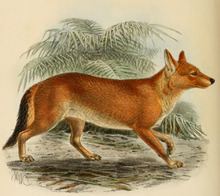Kingdom Animalia Class Mammalia Family Canidae | Phylum Chordata Order Carnivora Genus Cuon | |
 | ||
Similar Ussuri dhole, Nandiniidae, Tien Shan dhole, African golden wolf, Short‑eared dog | ||
The Sumatran dhole (Cuon alpinus sumatrensis syn. Cuon alpinus javanicus), also known as Javan dhole or Sumatran wild dog is a possible subspecies of dhole native to the Indonesian islands of Sumatra and Java. As it is also distributed in the Malayan peninsula, it is also known as Malay wild dog.
Contents
Evolutionary history
As of 2005, the origin of Sumatran dholes is unclear, as they show greater relatedness to Ussuri dholes rather than with those in nearby Malaysia. In the absence of further data, it is speculated that the dholes in Indonesia could have been introduced to the Sunda Islands by humans.
Physical descriptions
The Sumatran dhole is the smallest subspecies. It has a bright red fur. The Sumatran dholes lacks woolly underfur. Instead, it has a darker coarse and leaner fur similar to the southernmost populations of Ussuri dholes in India and Indochina, however it is much black on the back.
Range and habitat
The Sumatran dholes are native to Sumatra, Java, Peninsular Malasyia. Though their range are highly fragmented, the Indonesian dholes are confirmed to live in multiple protected areas of Sumatra and Java. In 2014, camera trap videos in the tropical forests of the Kerinci Seblat National Park in Sumatra revealed the continued presence of dholes in the area. The dholes have been extirpated from most of its range in Malaysia, although they probably still persist in Taman Negara and Belum-Temengor. The dholes are completely extinct from Singapore. Sumatran dholes live in scrublands, grasslands, plains, tropical forests and rainforests.
Threats
Habitat loss and fragmentation is a major threat to Sumatran dholes living in protected areas in Indonesia, particularly those on Sumatra. Habitat loss is driven by several different factors, including logging, palm and rubber plantations, agriculture expansion, rural biomass extraction, livestock grazing and major infrastructure expansion.
